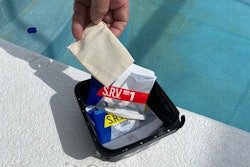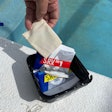
Many states have only general guidelines, but those that have detailed, comprehensive pool codes such as Florida and Nevada, along with the most in-depth service technician/operator certification programs, emphasize the importance of proper filtration and circulation. Along with sanitation regulations; user, structural, electrical safety requirements, circulation and filtration are also of key focus, yet they fail to go far enough. By all indications, based on its published proposed modules, the CDC is poised in its MAHC to be equally remiss.
It is mind-boggling that only half of the states even require a pool operator to receive formal training and certification by an authorized industry organization such as the National Swimming Pool Foundation (NSPF) or Association of Pool and Spa Professions (APSP).
At best, the codes include minimum turnover rates, almost universally requiring at least every one such turnover, every four hours for public pools (i.e. Southern Nevada Pool Code, section 610.10 Filtering and Circulation), or six per every 24 hours. They include maximum velocity rates, often not to exceed 10 feet per second (i.e. Florida Administrative Code (FAC), Chapter 64E-9.007 (10) Public Swimming Pools and Bathing Places, Recirculation and Treatment System Requirements). Some require “A portable or plumbed in vacuum cleaning system” (FAC, supra, subsection 12). However, nowhere are there any regulations or even guidelines that require (A) Minimum or even continuous filter flow rates, (2) Minimum filtering porosity (the size of the holes in a filter element) or (3) Specifics in regards to vacuum cleaning systems. Without these requirements, bathers are subject to exposure from virtually all pathogens not removed by sanitation, which by itself is inadequate. In addition, the prescribed turnover rates are misleading. They falsely imply that every four hours for a public pool and varying other time periods for other types of pools and spas, the entire volume of the pool is required to be filtered. As discussed below, the historic Gage and Bidwell Law of Dilution as far back as 1926 debunked that myth. Turnover actually is a quantitative, not qualitative standard.
It is estimated by industry sources and these programs that the great majority of all commercial (technically public) pools use high rate sand filters, with a porosity of 20 to 50 microns. There is a growing trend toward using diatomaceous earth (DE) filters with porosities below 5 microns, but they are extremely expensive to purchase and maintain. Certainly, all older public pools most often use high rate or their far less efficient predecessor, rapid rate sand filters
The overwhelming number of dangerous contaminants and unsightly debris such as fine sand, silt, algae and bacteria are well below 20 microns in size. The majority of these pathogens (disease-causing organisms) are between 2 and 20 microns. For example, the single most-focused recreational water disease-causing pathogens focused on by the NSPF, and the CDC are Cryptosporidium and Giardia, which according to Duke University’s Cruising Chemistry educational module, are 3-4 and 5-6 microns in diameter respectfully. E.coli, arguably the most generally known and feared pathogen found in pools, and along with that which causes Legionaire’s Disease, the only more prevalent one that has fatal consequences, is estimated to be 2 microns in length according to an article published by the American Ground Water Trust in the American Well Owner, 2002, Number 2.
While some of the most common pool contaminants such as viruses are below 2 microns, the majority can be filtered out with a filter that has porosity smaller than 20 microns, such as diatomaceous earth (DE) filters or most high-end robotic cleaners and some handheld-battery-powered pool and spa vacuums. But no regulation mandates there use.
Sanitation and oxidation will kill most of the pathogens, but their remnants still must be filtered out of the water. Here also lies a major misconception, namely that sanitizing a pool by adding disinfecting chemicals will remove the remnants of the killed pathogens. Overlooked is the fact circulating any chemical throughout the entire pool is a slow process that will take hours and hours in many instances. The code requirement that a pool cleaning system must have a vacuum available, and the ones that require brushing, another ambiguous, general regulation imply that this will be sufficient to rid the pool of dirt, debris and pathogens. That is but another misconception perpetuated or at least accepted.
The idea is that this debris on the walls, steps floors and everywhere else in a pool that static particles will adhere to, will be brushed into the water and then as it settles on the bottom be vacuumed into the filter system and be removed.
One problem with this is that all that will be removed are those particles that are larger than the porosity of the filter. At best in sand filters, it goes in one end and out the other, right back into the pool continuing to expose bathers.
There are maximum velocity requirements for two primary reasons, (1) The greater the velocity, the greater the suction, and the greater the suction created the greater the threat of bather entrapment, and (2) To preserve the life of the PVC piping system. The Virginia Graeme Baker Pool and Spa Safety Act (VGB) (15 USC 8001) virtually solved the majority of the entrapment problems. Compliance with the Act will and already has drastically reduced deaths or injuries from entrapment. Although the need for this federal law has been known for years and will save lives, with all due respect to those who revel in the accomplishment of having it signed into law by President George W. Bush, it merely addresses one critical area in needed pool legislation. There are other perhaps even more dangerous health and safety problems that must be solved. The CDC in a recent report of a survey estimated that of all the drowning deaths in the United States, only 8.6% occurred in swimming pools. There are no published statistics as to what percentage of these were from entrapment, but it must have been no more than 1-2% as it would be reasonable to believe that the majority occurred as a result of accidents, bathers who could not swim, aggressive play, diving accidents and other more likely causes. Also, it is reasonable to believe that most drownings do not occur in heavily-used public pools, but in backyard residential pools where observation and supervision of children is less likely. There is arguably a greater need for strong regulations to protect bathers from disease causing pathogens.
Turnover rates are probably the greatest misconception perpetuated. Often paraphrased and most of the time inaccurately, are the so-called Gage and Bidwell Laws of Dilution. The author has been only able to find one such law and only references to it and continues to seek the original report. In 1926 in a report by Joint Committee on Bath Places of the American Public Health Association (APHA) and the Conference of State Sanitary Engineers at the APHA’s 56th Annual Meeting, author Stephen DeM. Gage, Chairman of the Public Health Engineering Section of the APHA wrote:
“It can readily be demonstrated by computation and by experiment that 7 turnovers are required to effect a removal of 99.9 per cent of the dirt present in the water of the pool when recirculation was started. At the end of the first turnover the purification will be about 63 per cent, after two turnovers about 86 percent, at the end of three turnovers about 95 per cent, after four turnovers about 98 per cent, after five turnovers 99.3 per cent, and after six turnovers 99.7 per cent. To accomplish a purification of 99.99 per cent 10 turnovers will be required.”
The raw data and any detailed report do not appear to have been preserved, or at least are not readily available, but those who refer to it play fast and loose with these numbers. The National Parks and Recreation Association’s Certified Aquatic Facility Handbook states that the first turnover will filter less than half the water, and even include that as a question on its certification examination. There is no data to even imply modern filter systems have improved the numbers, nor any claim they have. Despite this lack of concern as to the accuracy of Drs. Gage and Bidwell’s findings, it is obvious those in the know are well aware of the fact that current regulations are inadequate to protect bathers from the constant risks they encounter every time they enter a swimming pool. It only takes exposure to a few molecules of a dangerous pathogen to infect an unsuspecting bather or swimmer. No process will entirely remove this risk, but there are methods and equipment that will significantly lessen the risk, only if the regulations address them.
It would be presumptuous to speculate on why this vital ingredient in aquatic safety has been delegated to secondary status in the regulations and certification courses. Neither The APSP 4-day, 10-hour a day Certified Service Technician’s course and accompanying nearly 500-page tech manual used as the course guide for its Certified Maintenance Specialist and the highest level certification in the industry its Certified Service Professional, the NSPF’s prestigious Certified Pool and Spa Operator (CPO) certification course and handbook, the NRPS certified Aquatic Facility Operator (AFO) course and handbook or the Aquatic Training Institutes certified Pool Technician course and handbooks give more than a passing reference, if that, to the importance of removing particles smaller than 20 microns from the pool. They and the regulations do not require any constant minimum filtration flow rates, nor do they mention, much less promote any need for pool vacuums than will filter these dangerous, sub 20 micron contaminants, despite the fact that there has long been cleaners and vacuums that will filter particles as small as 2 microns.
Bather safety is clearly a humane mission of the legislators, health and safety departments and certainly such eminent organizations like the CDC and NSPF. The need for a uniform, if not national aquatic safety code is obvious. However, to be truly effective and to protect bathers from the risks caused by dangerous pathogens, more stringent regulations are necessary.
Richard K. Cacioppo, Sr. J.D. is director of the Institute For Public Pool Studies, Princeton, New Jersey, and director of sales & marketing/administrative counsel at Water Tech Corp.







































